What did evenks get from modernization? global projects of the century and people's destinies
- Authors: Dolgikh D.A1, Shchekin M.A1
-
Affiliations:
- Russian State University for the Humanities
- Issue: No 5 (2023)
- Pages: 111-124
- Section: Articles
- URL: https://journals.rcsi.science/0869-5415/article/view/233751
- DOI: https://doi.org/10.31857/S0869541523050081
- EDN: https://elibrary.ru/YECIEC
- ID: 233751
Cite item
Full Text
Abstract
About the authors
D. A Dolgikh
Russian State University for the Humanities
Email: dolgikh-dmit@yandex.ru
M. A Shchekin
Russian State University for the Humanities
Email: smofficial@mail.ru
References
- Акимов Ю.Г. Северная Америка и Сибирь в конце XVI - середине XVIII в. Очерк сравнительной истории колонизаций. СПб.: Изд-во Санкт-Петербургского гос. ун-та, 2010.
- Виноградова С.Н. Формирование государственной политики в отношении коренных малочисленных народов Севера, Сибири и Дальнего Востока: ретроспективный анализ // Труды Кольского научного центра РАН (Апатиты). 2010. № 2. С. 127-139.
- Гаер Е.А., Батьянова Е.П., Шпинев В.Н. Коренные малочисленные народы Нижнего Амура в постсоветской действительности. Исследования по прикладной и неотложной этнологии. 2014. Вып. 228.
- Долгих Д.А., Корытин Г.С., Щекин М.А. В Верхнебуреинском районе Хабаровского края и Северо-Байкальском районе Республики Бурятия // Новые российские гуманитарные исследования (электронный журнал). 2021. Вып. 16. http://www.nrgumis.ru/articles/2173
- Забияко А.П. и др. Эвенки Приамурья: оленная тропа истории и культуры. Благовещенск: РИО, 2012.
- Поровознюк О.А. Городские аборигены БАМа: индустриальный бум, техносоциальные сети и борьба за ресурсы // Этнографическое обозрение. 2016. № 1. C. 23-41.
- Сирина А.А. Эвенки и эвены в современном мире: самосознание, природопользование, мировоззрение. М.: Восточная литература, 2012.
- Тураев В.А. Охотничий промысел коренных малочисленных народов Дальнего Востока в условиях постсоветской трансформации (1990-2010) // Россия и АТР. 2021. № 4. C. 12-27.
- Шубин А.С. Эвенки. Улан-Удэ: Республиканская типография, 2007.
Supplementary files










